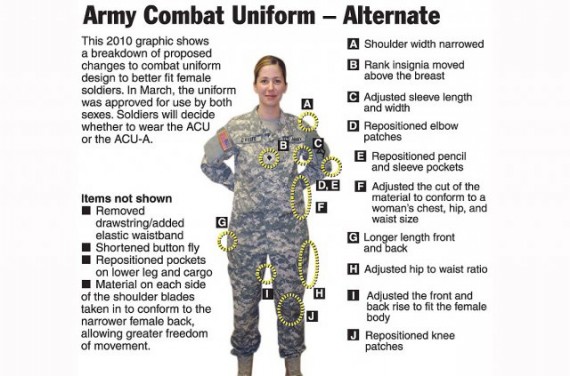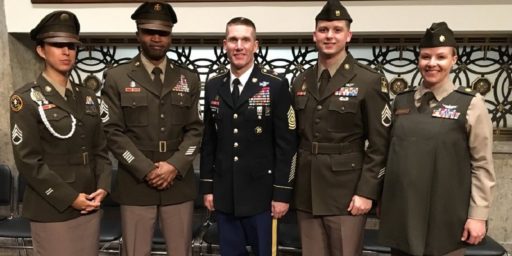Army Debuts Unisex Combat Uniform
The Army is fielding a new uniform to make ladies feel more soldierly.
The Army is fielding a new uniform to make ladies feel more soldierly.
AP (“Unisex Uniforms Debut As Army Opens Units To Women“):
A new combat uniform with special consideration to the female body is now available at Fort Gordon, almost a month after the Army announced plans to open all units and military jobs to women by 2016.
The March debut of the Combat Uniform-Alternate is the first in a series of moves the Army hopes to make in the next three years to help female soldiers feel like more professional members, officials said.
With narrower shoulders, a slightly tapered waist and a more spacious seat, the unisex clothing line has been in the works since 2009 and is being issued to all installations – except Fort Benning in Columbus, Ga. – for men and women with a smaller or more slender body.
Soldiers will soon be able to order the new uniform at the Fort Gordon Military Clothing store, according to Stefan Marks, the post exchange’s general manager.
Marks said all 16 sizes of the new line will be available to try on at the store in two to three weeks.
“After a soldier finds the right fit, they may place an order for the uniform, which will then be delivered to the store,” Marks said.
Unlike the decades-old Army combat uniform, which comes in 36 sizes and was designed principally by men for men, the alternate clothing line was created to fit a broader range of body types, officials say.
The trousers feature wider areas at the hips, waist and backside; elastic around the waistband instead of pull string; adjusted pockets and knee-pad inserts; and a shortened rise in pants.
The jackets include adjusted rank and name tape positioning, adjusted pockets and elbow-pad inserts, slimmer shoulders, a thinner and more fitted waist, and a longer and wider coat bottom.
Also, buttons are replacing the fabric fastener pockets.
According to a 2008 Army focus group report, “unisex” combat uniforms designed for men fit many women badly in the shoulders, bust, hips and crotch and left many buying larger sizes.
The Army designed a solution and had 400 active-duty and 200 National Guard and Reserve female soldiers fit-test the line in 2011.
Eighty-six percent said the coat fit better and 71 percent said the trousers fit better, Maj. Laverne Stanley, the assistant product manager of soldier clothing and individual equipment, said in a statement.
“An overwhelming majority, 94 percent of all respondents, said that the cut of the new ACU-A allowed them to present a better military appearance,” she said.
That the Army has managed to make something so simple—a fatigue uniform designed to be worn on the battlefield—and make it so complicated is impressive, indeed. The Battle Dress Uniform that debuted in the early 1980s and lasted through 2004, when it was replaced with the current Army Combat Uniform, came in four sizes: small, medium, large, and extra large.* The trousers and blouse were sold separately, allowing for some customization. When a soldier needed a new uniform, he went into the Clothing Sales store, picked one off the stack, and paid for it. We replaced that with a uniform that came in 36 sizes? And, now, in the name of “presenting a better military appearance,” we’re replacing that with one so customized that soldiers have to special order them?
Wouldn’t it be simpler to go back to the old concept of wearing service uniforms in garrison and saving fatigue and field uniforms for fatigue and field duty? Or . . . I don’t know . . . paying less attention to “military appearance” and more to “military proficiency”? Because this is all happening at a time of deep cuts to the defense budget.
_________________
*UPDATE: A commenter correctly informs me that my memory, faded by 21 years, is faulty. In fact, BDUs came in many more sizes. In addition to the Small, Medium, Large, and Extra Large than I remembered, there was also an Extra Small. Additionally, all five of those sizes came in four length variants: Short, Regular, Long, and Extra Long. I wore Small-Long trousers and a Medium-Long blouse.




For the record, BDUs – or “cammies” in the parlance I learned – came in a whole lot more than four sizes. Every piece had a width (chest for shirts, waist for pants) and a length.
I seem to recall wearing “Medium-Short” shirts and “Small-Regular” trousers.
Really? Taking a budget stand on uniform sizes? Brave move. Special order or not, you still have to pay for them (the Soldier, outside of official clothing allowance) so, how is that a problem? Explain how this will “fix” things? Have you ever had to wear a uniform that was made for a different gender? Nope, I imagine not. Though certainly not the most annoying, uncomfortable, or even silly thing the Army made me do, wearing a uniform designed to fit comfortably on a male form for ten years was pretty not awesome. The pockets were always in the wrong places, the tops had more shoulder room than I could even imagine being able to fill out without gaining tons of weight. Every day, I got to be reminded in a subtle way that the Army wasn’t for people like me. I know some people might think that is a “dramatic” way of thinking about it but it is one way in a million ways that you are reminded of your place in the service. So, calm down with your useless outrage about uniform sizes. Rail against defense spending, against poor senior leadership that sells out standards for retirement, about a runaway benefit system that is bloated and rewards troops in an all or nothing fashion, rail against radios that don’t communicate with one another, mini-empires of technology that is outdated but used anyway to support individual fiefdoms. Curse all of that, but let a woman pay for and wear a uniform on that fucking fits.
One thing I learned while working on an air crew mask program is how the diversity of shapes of the service men and women has greatly increased in the last fifty years. The complexity of fitting the human head with a gas mask that fits without leaking while having a limited selection of sizes (for logistcs reasons) is enormous. It is not just the addition of women that add to the complexity but the increase in those of Asian and African descent, among others to the Armed Forces mix. The old anthropological models were outdated and we had to create new models to accomodate the new reality.
The only part that will make any difference in the day to day lives of a female soldier is the repositioning of the knee patches/pads.
@Allan Bourdius: You’re right! I was going from faded memory (I’ve been out since 1992) and totally forgot about the varying lengths.
@Scott:
That’s probably true. But diversity in military equipment is something to be avoided. Especially if the diversity is only for appearance. It may look good, but all the diversity will make the equipment available in battle, when its value is most needed, scarce. Or if we get in a war where we don’t have a wide logistics pipe. The solution is not to diversify but to seek the universal fit with the fewest variations.
@JKB:
Very true but very tough to engineer to fit 95-98% of the population. Especially when effectiveness and reliability are key parameters.
And why did the Army introduce those ugly blue and white service uniforms? What the hell was wrong with the old green Class As?
@DC Loser: The Blues go back to before the Civil War and have been in the Army inventory ever since. (Indeed Army Blue goes back to the days of the Continental Army.) I happen to prefer it to the greens, especially the post-1981 variant with the lime green shirts. The problem is that it doesn’t work well without the tunic as a Class B uniform. The old solution was khakis for Bs but we got accustomed to having the ability to go from A to B and back simply by adding or subtracting a jacket.
The real cost issue from all this comes more from the fact that all four services wound up with their own utilities: ACU, ABU, NWU, and MARPAT. I seem to recall reading recently that they’re taking action to rectify that.
Of all of them, I actually think the NWU pattern was sort of a brilliant idea as since it’s a pixelated pattern, the blue/white/gray/black reflects shipboard paint colors and won’t show flecks assuredly picked up by sailors on painting duty. Because, the Navy SOP of course is:
1) If it moves, salute it.
2) If it doesn’t move, pick it up.
3) If you can’t pick it up, paint it.
LOL
And still no jodhpurs and puttees. Damn.
I’m sure some Army guy is waiting for the Sam Brown belts to come back.
Well, the real scandal here is that the Army is coming out with this right as Congress is forcing all the services to standardize uniforms. So these new sizes/styles will be “in the field” for a couple years until the new universal uniforms are issued.
You’re using “unisex” incorrectly. It means for both sexes as if one sex, not for one sex in particular. The current ACUs are unisex, and the new, alternate ones are not. Also, proficiency is important when choosing uniform sizes. The Army has also been experimenting with female IOTVs, as well, and as someone who has always had to wear a vest that doesn’t fit and is generally too big, I’m glad. Obviously, a soldier will use what’s available to get the job done, but if you have the option of something that fits better, why shouldn’t you go with that?